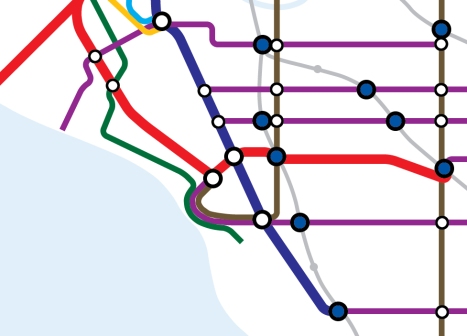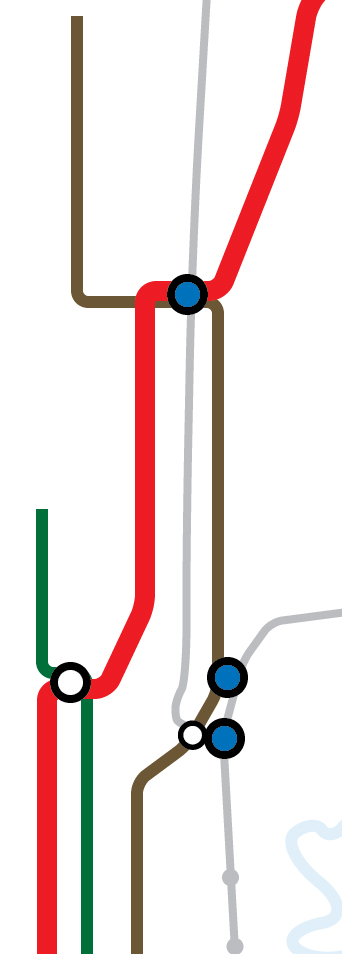I had actually started this post with the intention of discussing tram priority measures in Melbourne’s narrower streets. I was thinking about things like full time clearways, proper traffic light priority, blanket right turn bans etc., and whilst some of these might be sensible policies (especially traffic light priority and some right turn bans), I’d been approaching it from exactly the wrong way. Rather than trying to make street track as fast as reserve track, perhaps we should first aim to get the reserve track working like proper light rail. Under such a plan, we can – for want of a better term – get the low hanging fruit on the tram network and provide the biggest speed and capacity improvements at the lowest cost.
It’s predominantly the Dandenong Rd. tracks that have piqued my interest, and the idea of upgrading them has been covered extensively by Riccardo in the past. I didn’t initially realise the potential of the area, but with a bit of work, it could function as serious light rail. To do so, new high capacity vehicles would be required; as would platform stops at less frequent intervals, near instant light priority, basic signalling to prevent bunching and a high service standard (frequency of every 4 minutes of better, service at a high speed). The aerial photo below shows how substantial the reservation is.

But ultimately, a proper light rail network should be segregated from not only cars, but conventional street trams as well. For example, there’s a very compelling case for high standard light rail for Dandenong Rd, but that same case doesn’t really apply for Wattletree Rd. or Hawthorn Rd. Likewise, St. Kilda Rd. is ripe for a high capacity, segregated light rail upgrade, but High St., Malvern Rd. etc are not. Consequently, the street track sections need to run as shuttles and terminate at the light rail trunks. Yarra Trams have been advocating something along these lines for a while now – and good on them for doing so. But if a one size fits all approach is taken, the network is only as good as its weakest part – and in the case of Melbourne’s trams, that’s very worrying.
Some possible harebrained schemes to split up the tram system…
Following through with this logic dictates that Melbourne’s tram network would really become two distinct systems in terms of the service standard offered. One system would follow the current street tram set-up (although with ThinkTram and associated improvements), focussing predominantly on shorter trips. The other system would be based on high frequency, high capacity, high speed light rail. I’ve drawn up a speculative scheme based on this framework for the St. Kilda Rd. and Dandenong Rd. areas, shown below (note the map I made was basically drawn over the excellent Melbourne tram map on Wikipedia – hats off to the creator, John Shadbolt).

As you can see, I’ve connected Dandenong Rd. to the St. Kilda light rail via Fitzroy St. The Fitzroy St. connection would cost money to upgrade – probably substantial amounts at St. Kilda Junction (especially if flyovers are included), which is not purely in keeping with the ‘upgrade the easiest bits first’ philosophy I set out at the start of this post. However, these costs could well be offset by the benefits of the creation of a high standard light rail line. Also note that basically all the street trackage is running as feeder lines into the light rail/heavy rail trunks.
This arrangement largely mirrors my already stated plans for connecting up Plenty Rd., Nicholson St. and St. Georges Rd. as a single light rail line. For clarity, this is shown again below – perhaps the northern and southern light rail lines could be through-routed.

Speed and capacity of decent light rail
I’d argue there are three main things that separate Melbourne’s current trams from modern light rail – frequency, speed and capacity. The frequency issue has already been discussed – a 4 minute headway (or 15tph) seems about right to me, although St. Kilda Rd. really needs double that. It’s capacity and speed that warrant more thought.
In terms of capacity, the choice of vehicle is very important. Obviously running Z3s at a 4 minute headway isn’t going to to much for capacity – you need proper light rail vehicles. I don’t know enough to recommend a specific vehicle – just buy something off the shelf. However, Budapest’s version of the Combino Plus did attract my attention. At 54m long, it is the biggest passenger tram in the world, with a passenger capacity of 352. Run at a 4 minute headway, they could move 5280 people per direction per hour. For comparison, that’s about what Paul Mees claims the Dandenong line is handling at peak hour now.
Increasing speed is the trickiest part of the plan. It’s obviously easiest to do in reserve track areas, but even then, instant light priority is required to keep services moving smoothly. This could be likened to level crossings on the rail system – trains get absolute priority. Whilst this may not be easy to do in St. Kilda Rd. (given the sheer number of trams and large number of intersecting streets – some of which themselves have trams), it should be no substantial problem on Dandenong Rd. Fewer stops and the use of vehicles with lots of doors would be helpful too.
But even if you can get average speeds along Dandenong Rd. and the St. Kilda light rail up high enough, it’s all going to come crashing down at Whiteman St. Currently in peak hour, travel time on the 96 between Spring St. and Whiteman St. (some 2.8km) is timetabled at 20 minutes. The MMTB had a plan back in the 50s to underground the city tram lines – and let’s be frank, it was insane. Undergrounding traditional tram lines is crazy, it’s pricey and you lose many of the short trips that make trams so useful. But for light rail/premetro, the equation is perhaps somewhat different. I honestly don’t know whether it would work or not – and I’m prepared to be convinced either way.
Filed under: trams | 18 Comments »








